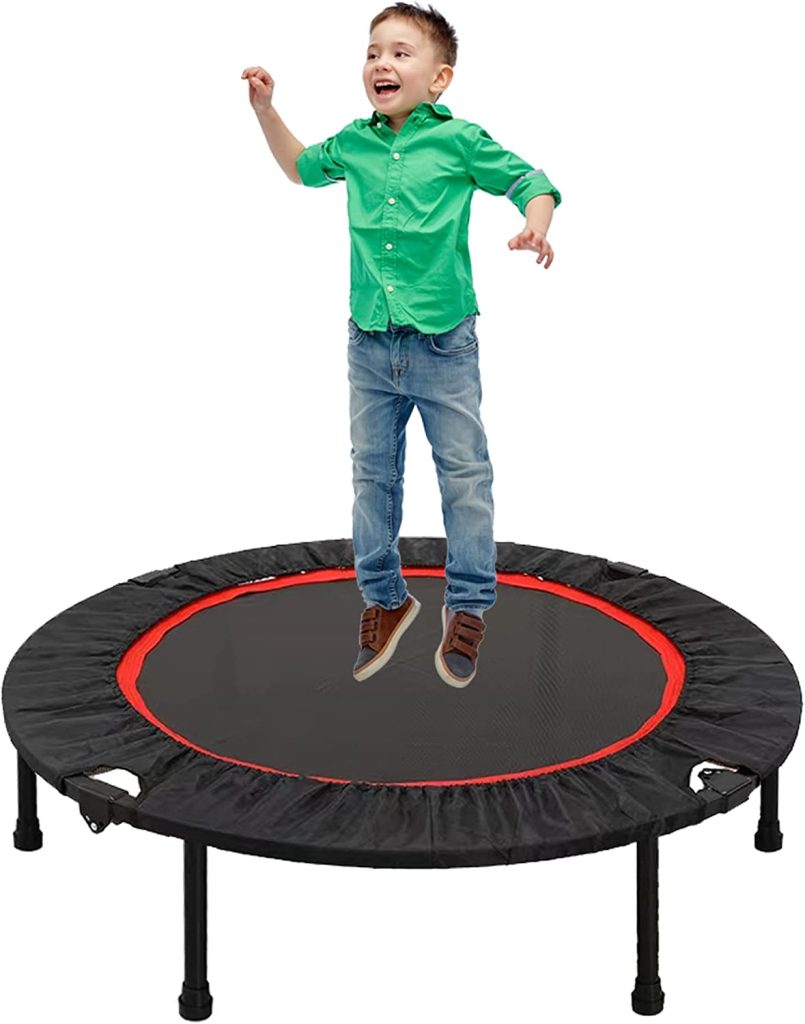Trampoline exercise has become increasingly popular in recent years as a fun and effective way to stay active. Jumping on a trampoline can provide a variety of health benefits, including improved cardiovascular health, increased muscle tone and strength, and improved coordination. However, like any form of exercise, trampoline exercise also has its downsides.
One of the main drawbacks of trampoline exercise is the risk of injury, particularly to the ankles and knees. Jumping on a trampoline puts stress on the joints and can lead to strains, sprains, and even fractures if proper safety precautions are not taken.
Additionally, trampoline exercise may not be suitable for individuals with certain health conditions, such as balance issues or joint problems.
Despite these drawbacks, many people continue to enjoy trampoline exercise and find it to be a fun and effective way to stay active.
In this article, we will explore the pros and cons of trampoline exercise to help you determine whether it is a good fit for your fitness routine.
Pros and cons of trampoline exercise: Trampoline exercise offers enjoyable, low-impact workouts improving balance and cardiovascular fitness. However, it poses injury risks, especially for novices, and limited exercise variety compared to traditional workouts.
Pros And Cons Of Trampoline Exercise

Trampoline exercise is an enjoyable and effective form of physical activity that offers numerous benefits. However, there are also some drawbacks to consider. Below are the pros and cons of trampoline exercise:
Pros of Trampoline Exercise
Trampoline exercise is a fun and effective way to stay active, and there are many benefits to incorporating it into your fitness routine. Here are some of the key pros of trampoline exercise:
Increases endurance:
Trampolining is an excellent cardiovascular workout that can improve endurance and stamina. The constant bouncing and jumping can increase heart rate and breathing, leading to improved cardiovascular fitness over time.
Excellent for balance and coordination:
Trampolining requires a high degree of balance and coordination, which can improve overall athleticism and reduce the risk of falls and other injuries.
High rate of caloric expenditure:
Trampolining is a high-intensity workout that can burn a significant number of calories. According to some estimates, trampolining can burn up to 400-600 calories per hour, depending on the intensity of the workout.
Low-impact cardio:
Trampolining is a low-impact form of cardio that can be easier on the joints than other high-impact exercises like running or jumping rope. This makes it a great option for those with joint pain or other physical limitations.
Coordination, agility, and stability training:

Trampolining can also improve coordination, agility, and stability. The constant bouncing and shifting of weight requires quick adjustments and can help to develop these important skills over time.
Overall, trampoline exercise is a fun and effective way to stay active and reap a variety of physical benefits. From improving cardiovascular fitness to developing balance and coordination, trampolining can be a great addition to any fitness routine.
Cons Of Trampoline Exercise
While there are many benefits to trampoline exercise, it is important to also consider the potential drawbacks. Here are some of the cons of trampoline exercise:
High risk of injury:
One of the biggest concerns with trampoline exercise is the risk of injury. Landing improperly or falling off the trampoline can lead to sprains, fractures, and other serious injuries.
Poor strength development:
Trampolining is primarily a cardiovascular workout, which means it may not be the best choice for those looking to build strength or muscle mass. While it can help to tone and firm muscles, it is not as effective for building muscle as weight lifting or other forms of strength training.
May cause nausea and dizziness:
Trampolining can be a very intense workout, and some people may experience feelings of nausea or dizziness as a result. This can be particularly true for beginners who are not used to the motion of bouncing on a trampoline.
Requires space and money:

Trampolines can be quite large and require a significant amount of space, which may not be feasible for everyone. Additionally, trampolines can be expensive to purchase and maintain, which may be a barrier for some people.
Overall, while trampoline exercise can be a fun and effective way to stay active, it is important to consider the potential risks and drawbacks before incorporating it into your fitness routine.
By taking the necessary precautions and being aware of the potential downsides, you can minimize the risks and enjoy the many benefits of trampoline exercise.
Who Should Perform Trampoline Exercise?
Trampoline exercise is a fun and effective way to improve cardiovascular fitness, balance, coordination, and endurance. However, trampoline exercise may not be suitable for everyone.
We will explore who can benefit from trampoline exercise and considerations for individuals with medical conditions.
Explanation of who can benefit from trampoline exercise
Trampoline exercise is suitable for people of all ages and fitness levels. It is a low-impact workout that can provide numerous health benefits. Here are some examples of people who can benefit from trampoline exercise:
Athletes:
Trampoline exercise is an effective way for athletes to improve their balance, coordination, and agility. It can also help them to develop explosive power and endurance.
Children:
Trampoline exercise is a fun and engaging way for children to stay active and healthy. It can help to develop their balance and coordination skills and promote overall physical fitness.
Older adults:
Trampoline exercise can be a great way for older adults to stay active and maintain their balance and coordination. It is a low-impact workout that can be easier on the joints than other forms of exercise.
People with joint pain:
Trampoline exercise can be a good option for people with joint pain or injuries. It is a low-impact workout that can help to improve strength, flexibility, and range of motion.
People with weight management goals:
Trampoline exercise is a high-intensity workout that can help to burn a significant amount of calories. It can be an effective way to achieve weight loss and weight management goals.
Considerations for individuals with medical conditions

While trampoline exercise is generally safe for most people, there are some considerations for individuals with medical conditions. Here are some examples:
Pregnant women:
Pregnant women should consult with their healthcare provider before beginning any new exercise program, including trampoline exercise. Trampoline exercise may not be suitable for all stages of pregnancy.
Individuals with balance or coordination issues:
Trampoline exercise requires good balance and coordination skills. Individuals with balance or coordination issues should consult with their healthcare provider before beginning trampoline exercise.
Individuals with heart or lung conditions:
Trampoline exercise is a high-intensity workout that can place a significant demand on the cardiovascular system. Individuals with heart or lung conditions should consult with their healthcare provider before beginning trampoline exercise.
Individuals with joint or bone conditions:
Trampoline exercise can be stressful on the joints and bones. Individuals with joint or bone conditions should consult with their healthcare provider before beginning trampoline exercise.
Individuals with other medical conditions:
Individuals with any other medical conditions should consult with their healthcare provider before beginning trampoline exercise.
Disadvantages of Trampoline Exercise
Trampoline exercise has gained popularity in recent years as a fun and effective way to improve fitness and overall health. However, it also has some disadvantages that should be considered before beginning a trampoline workout routine.
One of the main disadvantages is the risk of injury. Landing incorrectly on the trampoline can lead to sprains, strains, and even broken bones. Additionally, repetitive bouncing can cause wear and tear on joints, leading to long-term joint problems.
Another disadvantage is the limited range of exercises that can be performed on a trampoline. While it is great for cardio and lower-body strength training, it may not be as effective for upper-body workouts.
Finally, trampolines can be expensive and require a significant amount of space, making them impractical for some individuals. It is important to weigh the benefits and disadvantages of trampoline exercise before deciding if it is right for you.
Pros and Cons of Mini Trampoline Exercise
Mini trampolines, also known as rebounders, have become popular in recent years as a low-impact form of exercise that can be done at home. While they offer many benefits, they also have some drawbacks that should be considered.
One of the main pros of mini trampoline exercise is its low-impact nature, making it easier on joints and reducing the risk of injury. It is also a convenient and affordable way to improve cardiovascular health, burn calories, and tone muscles. Additionally, rebounding has been shown to improve balance and coordination.
On the other hand, one of the cons of mini trampoline exercise is that it may not be suitable for individuals with certain health conditions, such as back or joint problems. It can also be difficult to perform certain exercises on a mini trampoline due to its small size.
Finally, the quality and durability of the trampoline can vary, so it is important to do research and invest in a high-quality product.
Dangers of Mini Trampoline
While mini trampolines are a popular form of exercise, there are also potential dangers associated with their use. One of the main risks is the potential for injury. Bouncing too high or landing awkwardly can cause sprains, strains, and even broken bones.
In addition, the small size of a mini trampoline may make it more difficult to maintain balance and control while exercising.
It is important to use caution and follow proper safety guidelines when using a mini trampoline, such as wearing appropriate footwear and avoiding performing exercises that are too advanced or risky for your skill level.
Is Exercising on a Trampoline Good for You?

Trampoline exercise has become increasingly popular in recent years as a fun and effective way to stay fit and healthy. But is exercising on a trampoline actually good for you?
In this article, we’ll explore the benefits and risks of trampoline exercise to help you decide if it’s right for you.
Benefits of Trampoline Exercise
Trampoline exercise, also known as rebounding, is a low-impact cardiovascular workout that involves bouncing on a mini trampoline.
Here are some benefits of trampoline exercise:
Low-impact Cardio:
Trampoline exercise is a low-impact form of cardio, which means that it’s easier on your joints than high-impact exercises like running or jumping jacks. This makes it an ideal option for people with joint pain or injuries.
Aerobic Endurance:
Trampoline exercise is an excellent way to improve your aerobic endurance, as it requires constant movement and engages all major muscle groups in your body. Regular trampoline workouts can improve your cardiovascular health, help you burn calories, and boost your overall fitness level.
Coordination and Balance:
Trampoline exercise requires a lot of coordination and balance, as you have to maintain your body position while bouncing up and down. This can improve your overall balance and coordination, which can be particularly beneficial for older adults at a higher risk of falls.
Fun and Motivating:
Trampoline exercise is a fun and motivating way to stay active, which can help you stick to your fitness routine and achieve your health goals. It’s a great option for people who find traditional workouts boring or tedious.
Risks and Potential Negative Effects of Trampoline Exercise
Here are some risks and potential negative effects of trampoline exercise:
Risk of Injury:
Like any physical activity, trampoline exercise comes with a risk of injury. Falls from trampolines can cause sprains, strains, fractures, and even more serious injuries like spinal cord damage. To reduce your risk of injury, it’s important to use proper technique, wear appropriate footwear, and make sure that the trampoline is in good condition.
Not Suitable for Everyone:
Trampoline exercise is not suitable for everyone, particularly people with certain medical conditions like heart disease, high blood pressure, or joint problems. It’s important to talk to your doctor before starting any new exercise program, including trampoline exercise.
Motion Sickness:
Some people may experience motion sickness or dizziness when jumping on a trampoline, particularly if they are prone to motion sickness or have balance issues.
Cost:
Trampolines can be expensive, and not everyone has the space or budget to invest in one. If you’re considering trampoline exercise, it’s important to weigh the costs and benefits to determine if it’s the right option for you.
Are Trampoline Workouts Effective?

Trampoline workouts can be effective for improving cardiovascular fitness, increasing endurance, building muscle strength, and toning the body.
However, the effectiveness of trampoline exercise may vary depending on the individual’s fitness goals and personal preferences.
When compared to other forms of cardiovascular exercises, such as running, cycling, or swimming, trampoline exercise can provide similar benefits with less impact on the joints. This is particularly beneficial for individuals with joint pain or injuries who may not be able to engage in high-impact activities.
In addition, trampoline exercise has been found to increase heart rate and oxygen consumption, indicating that it can be an effective form of aerobic exercise.
Trampoline exercise can also be an effective form of strength training as it engages multiple muscle groups, including the legs, core, and upper body. This can lead to improved muscle tone and overall body composition.
In addition, the unstable surface of a trampoline can provide a unique challenge for the muscles, leading to increased muscle activation and recruitment.
One potential limitation of trampoline exercise is that it may not provide as much variety in terms of exercises and movements compared to other forms of exercise.
While trampoline workouts can be customized to target specific muscle groups and fitness goals, some individuals may find that they become repetitive over time.
Additionally, trampoline workouts may not be suitable for individuals who are very overweight or have limited mobility.
Overall, trampoline exercise can be an effective and fun way to improve cardiovascular fitness, build strength, and tone the body. As with any form of exercise, it is important to start slowly and gradually increase intensity and duration over time to avoid injury.
How Long Should You Jump On a Trampoline for a Workout?
Trampoline workouts are a fun and effective way to improve cardiovascular health, increase endurance, and enhance coordination and balance. However, it is important to approach trampoline workouts with caution and ensure that you are using proper technique and safety precautions.
When it comes to the recommended duration and frequency of trampoline workouts, there is no one-size-fits-all answer. The amount of time you should spend jumping on a trampoline for a workout will depend on your fitness level, goals, and any pre-existing medical conditions you may have.
For beginners, it is recommended to start with short, 10-15 minute sessions and gradually increase the duration and intensity of your workouts as your fitness level improves. Ideally, you should aim to exercise on the trampoline for at least 20-30 minutes per session, three to five times per week.
It is important to take rest days and allow your body time to recover between workouts. Overtraining can lead to fatigue, injury, and decreased performance. If you experience any pain or discomfort while exercising on the trampoline, it is important to stop immediately and seek medical attention if necessary.
It is also important to vary your trampoline workouts to prevent boredom and ensure that you are targeting different muscle groups. You can incorporate various exercises such as jumping jacks, high knees, and twists to work different parts of your body and keep your workouts challenging and engaging.
In summary, the recommended duration and frequency of trampoline workouts will depend on your individual fitness level, goals, and medical conditions.
It is important to start slowly and gradually increase the intensity and duration of your workouts while taking rest days and varying your exercises to prevent injury and maximize the benefits of trampoline exercise.
Trampoline Alternatives
Trampolining is a popular exercise that provides numerous benefits, including cardiovascular health, improved balance, coordination, and bone density. However, not everyone has access to a trampoline or may not feel comfortable using one due to safety concerns.
Fortunately, there are many alternative exercises and activities that can provide similar benefits. Here are some suggestions:
Jump Rope:
Jumping rope is an excellent cardio exercise that can improve your cardiovascular health and burn calories. It also helps to improve balance, coordination, and bone density, just like trampolining.
You can do it indoors or outdoors and don’t require much space. All you need is a good quality jump rope and some comfortable shoes.
Mini Trampoline:
If you still want to get the benefits of trampolining without the risks, a mini trampoline can be an excellent alternative. Mini trampolines are smaller and lower to the ground than traditional trampolines, making them safer and easier to use.
They provide similar benefits to full-sized trampolines, including improved cardiovascular health, balance, and coordination.
Plyometrics:
Plyometrics is a type of exercise that involves explosive movements like jumping, bounding, and hopping. It’s an effective way to improve cardiovascular health, burn calories, and improve bone density.
Plyometrics can be done anywhere and doesn’t require any equipment, making it an excellent alternative to trampolining.
Dance:
Dancing is a fun way to improve your cardiovascular health and coordination. It’s an excellent way to burn calories, and you don’t need any equipment to get started. There are many different types of dance, from ballroom to hip-hop, so you can choose the style that suits you best.
Hiking:
Hiking is a great way to improve your cardiovascular health, balance, and coordination. It’s an excellent way to get out into nature and enjoy the outdoors. Hiking can be challenging, depending on the terrain, so it’s a great way to improve your bone density.
Yoga:

Yoga is a low-impact exercise that can help to improve your balance, coordination, and flexibility. It’s an excellent way to reduce stress and improve your overall well-being.
Yoga doesn’t require any equipment, making it an easy and affordable alternative to trampolining.
Swimming:
Swimming is a great way to improve your cardiovascular health, balance, and coordination. It’s a low-impact exercise that’s easy on the joints, making it a great option for people with injuries or arthritis. Swimming also helps to improve bone density, making it an excellent alternative to trampolining.
Safety tips for trampoline exercise
Trampolines can be a fun and effective way to exercise, but it is important to prioritize safety to prevent injuries. Here are some safety tips to keep in mind when using a trampoline for exercise:
Proper warm-up and stretching:
Before starting any exercise, it is important to warm up properly and stretch to prevent muscle strains and injuries. This is especially important for trampoline exercise since it is a high-impact activity that can put stress on your joints.
Make sure to perform a full-body warm-up that includes movements that will prepare your muscles for jumping on a trampoline. Some examples of warm-up exercises include jogging in place, jumping jacks, and leg swings.
Use of safety equipment such as padding and enclosures:
Trampolines should be equipped with safety features such as padding and enclosures to minimize the risk of injury. Padding should cover the metal frame and springs of the trampoline to prevent injuries from accidental contact.
Enclosures, which are typically made of netting, should be used to keep jumpers from falling off the trampoline. It is important to ensure that the padding and enclosures are properly installed and in good condition before using the trampoline.
Supervision for children and beginners:
Children and beginners should always be supervised when using a trampoline. Children under the age of six should not be allowed to use a trampoline, as they are more susceptible to injuries.
Beginners should start with basic jumping exercises and gradually increase the intensity and complexity of their workout. It is important to have someone nearby who can monitor the jumper’s form and provide assistance if needed.
Regular maintenance and inspection of trampoline equipment:
Trampoline equipment should be regularly inspected and maintained to ensure its safety. Check for tears or holes in the padding and netting, as well as loose or broken springs.
Make sure that the trampoline is set up on a level surface and that the frame is stable. If you notice any damage or wear and tear, make sure to repair or replace the equipment before using the trampoline again.
Follow proper jumping techniques:
Jumping on a trampoline requires a proper form to prevent injuries. When jumping, keep your knees slightly bent and your feet shoulder-width apart. Always jump in the center of the trampoline, away from the padding and enclosure. Avoid attempting flips or other advanced maneuvers unless you have received proper training.
Limit the number of people on the trampoline:
To prevent collisions and injuries, it is important to limit the number of people jumping on the trampoline at one time. Ideally, only one person should use the trampoline at a time. If multiple people are using the trampoline, make sure that they are similar in weight and skill level.
Maintenance and Upkeep
Maintaining a trampoline is vital for its longevity and user safety. Regular inspections of the frame, springs, mat, and padding are essential to identify wear, tear, or rust. Cleaning off debris and dirt helps optimize performance and prevent slips.
Weather covers protect it during extreme conditions. Proper spring tension ensures bounce and stability. Secure safety nets and padding, while adhering to weight limits, to prevent accidents.
Educating users on safe practices and discouraging risky behaviors is crucial. Anchoring in windy areas prevents tipping. Adhering to manufacturer guidelines for maintenance and repairs ensures optimal performance.
Seeking professional help when unsure or faced with significant damage guarantees a safe and enjoyable trampoline experience.
FAQs:
Q.1 What are the benefits of trampoline exercise?
Trampoline exercise can offer a range of benefits, including improved cardiovascular health, increased strength and endurance, improved balance and coordination, and a fun way to stay active.
Q.2 Are there any risks or downsides to trampoline exercise?
Yes, trampoline exercise can be risky if proper safety precautions are not taken. Common risks include sprains, strains, and other injuries. Additionally, trampoline exercise may not be suitable for individuals with certain health conditions, such as heart disease or joint problems.
Q.3 How can I stay safe while using a trampoline?
To stay safe while using a trampoline, it’s important to follow these guidelines:
- Only use a trampoline with a safety net enclosure.
- Never use a trampoline when it’s wet or slippery
- Don’t attempt tricks or maneuvers that are beyond your skill level
- Always have a spotter or supervisor present
- Follow the manufacturer’s instructions for assembly and use
- Check the trampoline regularly for any signs of wear or damage
Q.4 What should I wear when using a trampoline?
It’s important to wear appropriate clothing and footwear when using a trampoline. Avoid loose or baggy clothing that could get caught in the springs or other parts of the trampoline. Wear athletic shoes with good support and grip to help prevent slips and falls.
Q.5 How can I get started with trampoline exercise?
If you’re new to trampoline exercise, start by practicing basic bounces and jumps. As you become more comfortable, you can try more advanced maneuvers like flips and spins.
Consider taking a trampoline class or working with a personal trainer who can guide you through proper technique and safety precautions. It’s also important to listen to your body and take breaks when you need to.
Conclusion:
In conclusion, trampoline exercise can provide a fun and effective way to stay active and improve overall health. The pros of trampoline exercise include improved cardiovascular health, increased muscle tone and strength, and improved coordination. However, the cons of trampoline exercise, such as the risk of injury, should not be overlooked.
Trampoline exercise is generally safe for healthy individuals with proper safety precautions, including proper warm-up and stretching, use of safety equipment such as padding and enclosures, and regular maintenance and inspection of trampoline equipment.
However, individuals with medical conditions or balance issues should consult with their healthcare provider before attempting trampoline exercise.
Overall, trampoline exercise can be a great addition to a fitness routine for those who enjoy it and take the necessary safety precautions. It is important to consider the benefits and risks, as well as individual fitness goals and abilities when deciding whether to incorporate trampoline exercise into a fitness routine.
We hope that after reading this guide about the pros and cons of trampoline exercise, you have a good understanding of the topic. If you have any questions, please feel free to ask us in the comments section.

